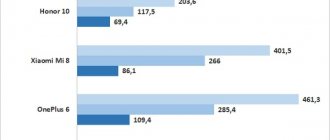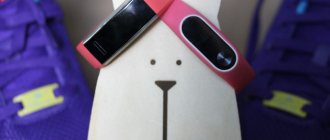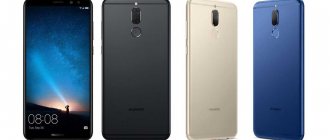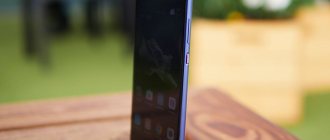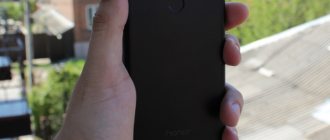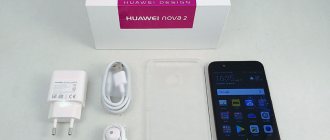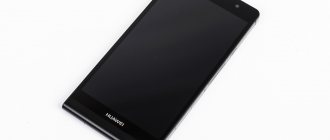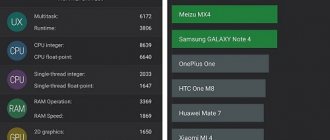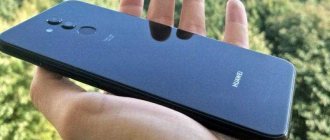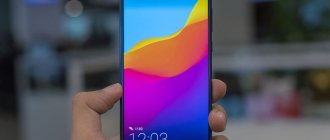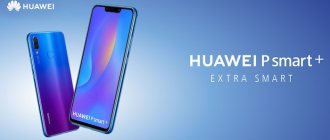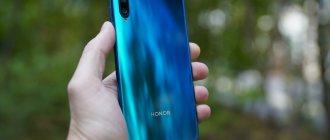General impression
The first thing to note about this smartphone is that it is not for you if you like phones with large screens. The screen diagonal of Huawei Nova 2 is exactly five inches.
The thickness of the case is very small and is only 6.9 mm. The scratch resistance of the case is at a fairly high level. During the test, when the smartphone was used as the main means of communication for a week and a half, it was not possible to cause any serious damage to it. At the same time, it was used without covers or films. He rarely found himself with iron keys or small change in one pocket, but plastic objects like a car key came across regularly. Many smartphones scratch significantly more under similar operating conditions.
The camera windows are protected from scratches by small protruding rims. It is difficult to say how much this will save during long-term use, but during the test they remained in pristine condition.
The design of Nova 2 can hardly be called original. Externally, it is very similar to the iPhone, OnePlus 5, Pixel and some other devices. But, on the other hand, the designers from Huawei also did not just come up with this design with rounded edges and an aluminum-magnesium body. We have already seen all this in other models of the company.
The fingerprint scanner is located on the rear panel. Volume and Power buttons on the side. On the left is a tray for two SIM cards and a memory card. Below is a minijack, which still tries to maintain its place on the body of modern smartphones. Next to it is one speaker and USB Type-C version 2.0.
Review of the Huawei Nova 2 smartphone: a medium-sized mid-level model with high-quality cameras
Content
- Specifications
- Equipment
- Appearance and ease of use
- Screen
- Camera
- Telephone and communications
- Software and multimedia
- Performance
- Thermal photographs
- Playing video
- Battery life
- Bottom line
At the end of July, Huawei Consumer Business Group introduced new smartphones of its Nova series, which appeared just a year ago, for the Russian market: they were the Huawei Nova 2 and Nova 2 Plus models. The smartphones received three body color options and a rich set of additional features, including a unique front camera and a new audio system. The dual main camera of both models, assembled from 12-megapixel and 8-megapixel modules, has a professional portrait mode, and the 20-megapixel front camera provides high-quality self-portraits, expanding the creative possibilities of users. Today we present a detailed review of the simplest and at the same time the most balanced of these two models - Huawei Nova 2.
Main characteristics of Huawei Nova 2 (model PIC-LX9)
- SoC HiSilicon Kirin 659, 8 cores Cortex-A53 ( [email protected] .4 GHz + [email protected] .7 GHz)
- GPU Mali-T830 (MP2)
- Operating system Android 7.0, EMUI 5.1
- Touch display IPS 5″, 1920×1080, 443 ppi
- Random access memory (RAM) 4 GB, internal memory 64 GB
- Nano-SIM support (2 pcs.)
- MicroSD support up to 128 GB
- GSM/GPRS/EDGE networks (850/900/1800/1900 MHz)
- WCDMA/HSPA+ networks (850/900/1900/2100 MHz)
- Networks LTE Cat.6 FDD (B1/3/4/7/8/20), TD (B38)
- Wi-Fi 802.11b/g/n (2.4 GHz)
- Bluetooth 4.2
- GPS, A-GPS, Glonass, BDS
- USB Type-C, USB OTG
- 12 MP main camera, f/1.8 wide-angle lens, autofocus, 1080p video
- Additional camera 8 MP, f/2.4 telephoto lens
- Front camera 20 MP, f/2.0, fixed. focus
- Proximity sensor, lighting sensor, magnetic field sensor, fingerprint sensor, accelerometer, gyroscope, step counter
- Battery 2950 mAh
- Dimensions 142×69×6.9 mm
- Weight 142 g
| average price |
| find out the price |
| Retail offers |
| find out the price |
Appearance and ease of use
In design, the latest Huawei smartphones differ little from each other: they all have the same iPhone-like, sleek style of an all-metal body that is streamlined on all sides with strongly rounded corners. The developers do not hide the fact that the entire line of small, but technically worthy equipped Nova smartphones is designed primarily for a female audience.
Huawei Nova 2 has an aluminum-magnesium body that is durable, thin and quite light. There are no plastic inserts in the metal case; external antennas are usually placed in external grooves covered with composite material. The surface of anodized aluminum is matte, slightly rough, and there are practically no fingerprints on it.
The smartphone is not large in size, it fits comfortably in the hand, does not slip out, and does not weigh on your pockets. By modern standards, such a device can be called elegant.
The rear panel houses a dual camera module with flash. The flash is single, consists of one LED, but shines quite brightly.
The fingerprint sensor area is only slightly recessed (depth is only 0.1 mm). The fingerprint scanner is protected from dirt and dust and fits well into the overall appearance of the device. There are no complaints about the scanner's operation; you can place your finger at any angle.
The front panel is completely covered with 2.5D glass with sloping edges. In the upper part above the screen there are usually sensors, a front camera eye, and an LED event indicator. Its small, barely noticeable dot shines almost in the middle above the speaker grille.
There are no hardware control buttons under the screen, but you can customize the set of buttons in the panel on the screen.
The side keys are larger than you might expect, and they are quite hard. The buttons have different surface textures, but they feel the same to the touch.
The side card slot is hybrid: a Nano-SIM card is inserted into one of the slots, a microSD memory card or, in the case of a Dual SIM modification, a second Nano-SIM format SIM card is inserted into the other. The slides are not metal, but plastic; they hold the cards and do not fall out.
The bottom end is given over to a 3.5 mm headphone jack, a microphone hole, a main speaker output and a USB Type-C connector. Thus, there is nothing on the top end except the auxiliary microphone hole. There is also no infrared transmitter used for smartphones from this manufacturer to emulate a remote control.
Huawei Nova 2 is available in black (“Graphite Black”), gold (“Prestige Gold”) and blue colors. Unlike many manufacturers, Huawei designers decided not to paint the front panel of Nova 2 to match the overall color of the body - it comes only in black or white.
Screen
Huawei Nova 2 is equipped with an IPS display with 2.5D protective glass. The screen dimensions are approximately 62x110 mm with a diagonal of 5 inches. The resolution is 1920×1080, the pixel density is about 443 ppi.
You can adjust the display brightness manually or use automatic settings based on the ambient light sensor. Multi-touch tests diagnose support for 6-9 simultaneous touches, but not a single test showed all 10. The screen supports operation with gloves, but this mode should be looked for not in the section about the screen, but in the button control settings.
A detailed examination using measuring instruments was carried out by the editor of the “Monitors” and “Projectors and TV” sections Alexey Kudryavtsev
. Here is his expert opinion on the screen of the sample under study.
The front surface of the screen is made in the form of a glass plate with a mirror-smooth surface that is scratch-resistant. Judging by the reflection of objects, the anti-glare properties of the screen are better than those of the Google Nexus 7 (2013) screen (hereinafter simply Nexus 7). For clarity, here is a photo in which a white surface is reflected in the switched off screens (on the left - Nexus 7, on the right - Huawei Nova 2, then they can be distinguished by size):
The screen of the Huawei Nova 2 is noticeably darker (brightness according to photographs is 104 versus 118 for the Nexus 7). The ghosting of reflected objects in the Huawei Nova 2 screen is very weak, this indicates that there is no air gap between the layers of the screen (more specifically, between the outer glass and the surface of the LCD matrix) (OGS - One Glass Solution type screen). Due to the smaller number of boundaries (glass/air type) with very different refractive indices, such screens look better in conditions of intense external illumination, but their repair in the case of cracked external glass is much more expensive, since the entire screen has to be replaced. On the outer surface of the screen, there is a special oleophobic (grease-repellent) coating, which is better in efficiency than that of the Nexus 7. Therefore, fingerprints are removed much easier here and appear at a lower speed than in the case of regular glass.
When manually controlling the brightness and displaying the white field in full screen, the maximum brightness value was about 500 cd/m², the minimum was 2 cd/m². The maximum brightness is high, and given the excellent anti-glare properties, readability even on a sunny day outdoors should be at an acceptable level. In complete darkness, the brightness can be reduced to a comfortable value. There is automatic brightness adjustment based on the light sensor (it is located to the left of the front speaker slot). In automatic mode, as external lighting conditions change, the screen brightness both increases and decreases. The operation of this function depends on the position of the brightness adjustment slider; the user can use it to try to set the desired brightness level in the current conditions. We increased the brightness to the desired level in complete darkness and found that in complete darkness the auto-brightness function reduces the brightness to 12 cd/m², in an artificially lit office (approximately 550 lux) it sets it to 180 cd/m², in a very bright environment (corresponding to lighting on a clear day outdoors, but without direct sunlight - 20,000 lux or a little more) increases to 500 cd/m². We were quite pleased with the result. It turns out that the auto-brightness function works adequately and to some extent allows the user to adjust their work to individual requirements. At any brightness level, there is no significant backlight modulation, so there is no screen flicker.
This smartphone uses an IPS matrix. The microphotographs show a typical IPS subpixel structure:
For comparison, you can see the gallery of microphotographs of screens used in mobile technology.
The screen has good viewing angles without significant color shift even with large viewing deviations from perpendicular to the screen and without inverting shades. For comparison, here are photographs in which the same images are displayed on the screens of Huawei Nova 2 and Nexus 7, while the screen brightness is initially set to approximately 200 cd/m², and the color balance on the camera is forced to switch to 6500 K.
There is a white field perpendicular to the screens:
Note the good uniformity of brightness and color tone of the white field.
And a test picture:
The colors on the Huawei Nova 2's screen are a bit oversaturated (note the bananas, tomatoes, napkin and skin tone) and the color balance is slightly off.
Now at an angle of approximately 45 degrees to the plane and to the side of the screen:
It can be seen that the colors have not changed much on both screens, but on the Huawei Nova 2 the contrast has decreased to a greater extent due to the strong highlighting of black.
And a white field:
The brightness of the screens at an angle decreased (by at least 5 times, based on the difference in shutter speed), but in the case of Huawei Nova 2 the drop in brightness is slightly greater. When deviated diagonally, the black field brightens greatly and acquires a slight reddish tint. The photographs below demonstrate this (the brightness of the white areas in the direction perpendicular to the plane of the screens is the same!):
And from another angle:
When viewed perpendicularly, the uniformity of the black field is excellent:
The contrast (approximately in the center of the screen) is high - about 1100:1. The response time for the black-white-black transition is 24 ms (13 ms on + 11 ms off). The transition between halftones of gray 25% and 75% (based on the numerical value of the color) and back takes a total of 46 ms. The gamma curve, constructed using 32 points with equal intervals based on the numerical value of the shade of gray, did not reveal any blockage in either the highlights or the shadows. The exponent of the approximating power function is 2.42, which is higher than the standard value of 2.2. In this case, the real gamma curve deviates little from the power-law dependence:
This device has some kind of dynamic adjustment of the backlight brightness in accordance with the nature of the displayed image. As a result, the resulting dependence of brightness on hue (gamma curve) may not correspond to the gamma curve of a static image, since the measurements were carried out with sequential display of shades of gray on almost the entire screen. For this reason, we carried out a number of tests - determining contrast and response time, comparing black illumination at angles - (however, as always) when displaying special templates with a constant average brightness, and not monochromatic fields in the entire screen. It should be noted that in this case, the brightness correction is weakly expressed and has a not entirely obvious dependence on the image, but it would be better not to have it at all.
Color gamut is slightly wider than sRGB:
The spectra show that the matrix filters moderately mix the components with each other:
As a result, visually the colors on this screen are somewhat different from natural ones, since almost all images are designed for display on display devices with sRGB coverage. The balance of shades on the gray scale is average, since the color temperature is significantly higher than the standard 6500 K, but the deviation from the blackbody spectrum (ΔE) is below 10, which is considered an acceptable indicator for a consumer device. At the same time, the color temperature changes little from shade to shade - this has a positive effect on the visual assessment of color balance. (The darkest areas of the gray scale can be ignored, since color balance there is not very important, and the error in measuring color characteristics at low brightness is large.)
This device has the ability to adjust the color balance by adjusting the hue on the color wheel.
In the graphs above, the curves are Without corr.
correspond to the results without any color balance correction, and the curves
Corr.
— data obtained after shifting the point to the position indicated in the image above. It can be seen that the change in balance corresponds to the expected result, since the color temperature has approached the standard value and ΔE has decreased on average. However, it doesn’t make much sense to make the correction. Note that this function is implemented more for show, since there is no numerical reflection of the correction, there is no field for measuring color balance and the adjustment range is insufficient, since even at the edge of the circle one has to find a compromise between a color temperature close to 6500 K and the minimum value of ΔE .
To summarize: the screen has a high maximum brightness and has excellent anti-glare properties, so the device can be used outdoors without any problems, even on a sunny summer day. In complete darkness, the brightness can be reduced to a comfortable level. It is also possible to use a mode with automatic brightness adjustment, which works adequately. The advantages of the screen include an effective oleophobic coating, the absence of air gaps in the layers of the screen and flickering, as well as high contrast and excellent uniformity of the black field. The disadvantages are the low stability of black to the deviation of the gaze from perpendicular to the screen plane, excessive color saturation, as well as the non-disabled dynamic adjustment of the backlight brightness. Nevertheless, taking into account the importance of characteristics for this particular class of devices, the quality of the screen can be considered high.
Camera
The front camera module is one of the main points of pride for the creators of Huawei Nova 2. The fact is that the smartphone has a sensor with a very high resolution for a selfie camera of 20 megapixels, as well as a lens with an f/2.0 aperture - although without its own flash and autofocus. The camera features 3D technology for accurate face recognition. The quality of the images is not bad: the image sensor has good photosensitivity, color rendition is normal. The photos look very good on a smartphone screen, but when viewed on a computer, the level of detail is not amazing.
By default, this camera has a background blur mode enabled, although selfies are probably more often taken to capture a specific background and then show it off to viewers. Of course, this effect can be disabled in the settings, but by default it is turned on, apparently to immediately impress new users with technology.
The main camera uses the now familiar set of two modules, one of which has a wide-angle lens with an f/1.8 aperture and a 12 MP sensor, and the second is equipped with a telephoto lens with an f/2.4 aperture and an 8 MP sensor. Thanks to this, the camera provides the ability to double optical zoom, as well as blur the background with a bokeh effect.
The menu has manual settings for photo and video shooting: shutter speed (from 1/4000 to 30 s), photosensitivity (up to ISO 3200), exposure compensation, white balance, and focusing options. You can reach them by sliding out the panel from below, that is, manual mode is always at hand here. It also becomes possible to save pictures in RAW. The camera offers a large number of scene modes (from HDR to shooting light or food), some of them can be downloaded yourself.
The camera can shoot video in a maximum resolution of Full HD (1920×1080) at a speed of 30 fps; there are no 4K and 60 fps modes. The camera copes well with video shooting, but not perfectly: sharpness and color rendition are ok, but detail is not maximum, greens sometimes merge into mush. Brightness is also not always enough. There are no complaints about sound recording: the sensitivity of the microphones is high, the sound is clear and loud, the noise reduction system adequately copes with wind noise without adding noticeable distortion in the form of an echo.
- Video No. 1 (20 MB, 1920× [email protected] fps, H.264, AAC)
- Video No. 2 (28 MB, 1920× [email protected] fps, H.264, AAC)
Below are examples of photographs with our comments on quality. Our specialist Anton Soloviev
.
| Good detail in the background. | |
| The camera copes well with macro photography. | |
| The camera also does macro photography well in low light. | |
| Excellent sharpness across the frame. | |
| Good detail in the background. | |
| Good sharpness across the field and plans. | |
| The camera copes well with shooting in room lighting. | |
| The text is well done. |
RAW won't allow you to increase detail, but it's easy to expand dynamic range.
The camera turned out to be quite interesting. She works well, without noticeable flaws, in detailing the field of the frame and the plans. The noise is almost unnoticeable, but the noise reduction works very moderately. Shooting in RAW, of course, does not open up many possibilities, but it cannot be called useless either: if desired, you can tighten the exposure and light/shadow in the photographs taken, and this will be much more effective than when working with JPEG. As a result, the Huawei Nova 2 camera will cope well with many scenarios when shooting documentary or art.
Telephone and communications
The communication capabilities of Huawei Nova 2 include support for data transmission at speeds of up to 300 Mbps in LTE Cat.6 networks. In the urban areas of the Moscow region, the device behaves confidently, does not lose connection in places where reception is uncertain, and quickly restores the connection. The remaining features are not so rich: Bluetooth has version 4.2, only one Wi-Fi band is supported (2.4 GHz), and there is no NFC module at all.
The navigation module works with GPS (with A-GPS), with the domestic Glonass and the Chinese Beidou. During a cold start, the first satellites are detected within tens of seconds, and the positioning accuracy is high. There is a built-in magnetic field sensor for compass operation.
The phone application supports Smart Dial, that is, while dialing a phone number, a search is immediately carried out by the first letters in contacts. Methods for sorting and displaying contacts are standard for the Android interface.
In conversational dynamics, the voice of a familiar interlocutor is clearly recognizable, there is no extraneous noise, the sound is natural, clear, and the volume margin is sufficient. The vibration alert is extremely powerful, you definitely won’t miss it.
The platform does not support active standby of both SIM cards in 3G/4G at the same time. That is, if one card is assigned to transmit data in 3G/4G, the other may be actively waiting on the network only in 2G. The interface in Huawei smartphones traditionally does not offer to pre-select a specific card for sending SMS; this can only be done for voice calls and data transfers. The cards operate in Dual SIM Dual Standby mode, there is only one radio modem.
Software and multimedia
The software platform used is Android OS, not the latest version 7.0, and its own shell, the latest version EMUI 5.1 - everything is the same as in other modern devices from the manufacturer. Naturally, there is the possibility of updating over the air (OTA).
The interface is designed in its own well-recognized corporate style. It is possible to enable the standard Android version of the launcher, which is more familiar to Europeans, with a separate program menu. There are many pre-installed applications, including Sberbank’s mobile bank, new Yandex programs and several of Huawei’s own utilities. There is a comprehensive Phone Manager responsible for system monitoring, memory cleaning, virus scanning and protection, spam blocking, etc.
To listen to music, instead of the standard Google Music player, you use your own audio player with a familiar interface. All settings become available only with connected headphones, including equalizer presets. Thanks to the dedicated AK4376A audio chip, the sound has a very high maximum volume, the sound is bright, thick and rich, even at the maximum level the speaker does not start to wheeze. With headphones the quality is even better, the sound is bright, rich and also very loud. The 3D surround sound effect is available for the headphones—Huawei Histen proprietary features.
Performance
The Huawei Nova 2 hardware platform is based on the HiSilicon Kirin 659 SoC. The chip configuration includes eight ARM Cortex-A53 processor cores in two clusters with a maximum frequency of 2.36 and 1.7 GHz. Essentially, this is an overclocked version of the Kirin 655 SoC. Kirin 659 is also made using a 16nm process technology. The ARM Mali-T830 (MP2) video accelerator with support for the OpenGL ES 3.2 graphics API is responsible for graphics processing. The amount of RAM is 4 GB, built-in flash memory is 64 GB. Of this, 1.9 GB of RAM and about 51.4 GB of total memory are free.
It is possible to expand the memory by installing microSD cards, but applications are not installed on the memory card. You can also connect external flash drives in USB OTG mode.
SoC HiSilicon Kirin 659 is a relatively new solution designed for mid-range smartphones and tablets. The SoC is quite productive, at the level of Qualcomm Snapdragon 625; in the AnTuTu test, the hero of the review demonstrates a quite decent 60K-plus points, this is a confident average level.
Kirin 659 provides the system with reliable performance and in real scenarios allows the smartphone to cope with any modern tasks. There are no problems with games either; all the games we tested, including Modern Combat 5 and Mortal Kombat X, run smoothly.
Testing in comprehensive tests AnTuTu and GeekBench:
For convenience, we have compiled all the results we obtained when testing the smartphone in the latest versions of popular benchmarks into tables. The table usually adds several other devices from different segments, also tested on similar latest versions of benchmarks (this is done only for a visual assessment of the obtained dry figures). Unfortunately, within the framework of one comparison it is impossible to present the results from different versions of benchmarks, so many worthy and relevant models remain “behind the scenes” - due to the fact that they once passed the “obstacle course” on previous versions of test programs.
| Huawei Nova 2 (HiSilicon Kirin 659) | Sony Xperia XA1 (MediaTek MT 6757) | HTC One X10 (MediaTek MT6755) | Asus Zenfone 3 (Qualcomm Snapdragon 625) | Nokia 5 (Qualcomm Snapdragon 430) | |
| AnTuTu (v6.x) (bigger is better) | 60485 | 61638 | 50597 | 63146 | 45287 |
| GeekBench (v4.x) (bigger is better) | 904/3513 | 814/3518 | 757/2071 | 831/4092 | 672/2867 |
Testing the graphics subsystem in gaming tests 3DMark, GFXBenchmark and Bonsai Benchmark:
When testing in 3DMark, the most powerful smartphones now have the ability to run the application in Unlimited mode, where the rendering resolution is fixed at 720p and VSync is disabled (which can cause the speed to rise above 60 fps).
| Huawei Nova 2 (HiSilicon Kirin 659) | Sony Xperia XA1 (MediaTek MT 6757) | HTC One X10 (MediaTek MT6755) | Asus Zenfone 3 (Qualcomm Snapdragon 625) | Nokia 5 (Qualcomm Snapdragon 430) | |
| 3DMark Ice Storm Sling Shot ES 3.1 (bigger is better) | 413 | 671 | 421 | 466 | 299 |
| GFXBenchmark Manhattan ES 3.1 (Onscreen, fps) | 5,2 | 15 | 5 | 6 | 10 |
| GFXBenchmark Manhattan ES 3.1 (1080p Offscreen, fps) | 4,7 | 6 | 5 | 6 | 4,6 |
| GFXBenchmark T-Rex (Onscreen, fps) | 20 | 32 | 17 | 22 | 20 |
| GFXBenchmark T-Rex (1080p Offscreen, fps) | 18 | 21 | 17 | 23 | 16 |
Browser cross-platform tests:
As for benchmarks for assessing the speed of the javascript engine, you should always make allowance for the fact that their results significantly depend on the browser in which they are launched, so the comparison can only be truly correct on the same OS and browsers, and this is possible during testing not always. For Android OS, we always try to use Google Chrome.
| Huawei Nova 2 (HiSilicon Kirin 659) | Sony Xperia XA1 (MediaTek MT 6757) | HTC One X10 (MediaTek MT6755) | Asus Zenfone 3 (Qualcomm Snapdragon 625) | Nokia 5 (Qualcomm Snapdragon 430) | |
| Mozilla Kraken (ms, less is better) | 8887 | 9284 | 9992 | 8179 | 12559 |
| Google Octane 2 (bigger is better) | 4828 | 4489 | 3928 | 5036 | 2823 |
| SunSpider (ms, less is better) | 1310 | 946 | 1104 | 877 | 1970 |
AndroBench memory speed test results:
Thermal photographs
Below is a thermal image of the rear surface obtained after 10 minutes of running the battery test in the GFXBenchmark program:
Heating is more localized in the upper part of the device, which apparently corresponds to the location of the SoC chip. According to the heat chamber, the maximum heating was 37 degrees (at an ambient temperature of 24 degrees), which is not very much.
Playing video
To test the omnivorous nature of video playback (including support for various codecs, containers and special features, such as subtitles), we used the most common formats, which make up the bulk of the content available on the Internet. Note that for mobile devices it is important to have support for hardware video decoding at the chip level, since it is most often impossible to process modern options using processor cores alone. Also, you shouldn’t expect a mobile device to decode everything, since the leadership in flexibility belongs to the PC, and no one is going to challenge it. All results are summarized in a table.
| Format | Container, video, sound | MX Video Player | Standard video player |
| 1080p H.264 | MKV, H.264 1920×1080, 24 fps, AAC | plays normally | plays normally |
| 1080p H.264 | MKV, H.264 1920×1080, 24 fps, AC3 | plays normally | plays normally, no sound |
| 1080p H.265 | MKV, H.265 1920×1080, 24 fps, AAC | plays normally | plays normally |
| 1080p H.265 | MKV, H.265 1920×1080, 24 fps, AC3 | plays normally | plays normally, no sound |
Further testing of video playback was performed by Alexey Kudryavtsev
.
We could not check the theoretically possible support for adapters for outputting images to an external device, due to the lack of an adapter option that connects to the USB Type C port, so we had to limit ourselves to testing the output of video files on the screen of the device itself. To do this, we used a set of test files with an arrow and a rectangle moving one division per frame (see “Method for testing video playback and display devices. Version 1 (for mobile devices)”). Screenshots with a shutter speed of 1 s helped determine the nature of the output of frames of video files with various parameters: the resolution varied (1280 by 720 (720p), 1920 by 1080 (1080p) and 3840 by 2160 (4K) pixels) and frame rate (24, 25, 30, 50 and 60 fps). In the tests we used the MX Player video player in the “Hardware” mode. The test results are summarized in the table:
| File | Uniformity | Passes |
| 4K/60p (H.265) | cannot be played | |
| 4K/50p (H.265) | Fine | No |
| 4K/30p (H.265) | Fine | No |
| 4K/25p (H.265) | Fine | No |
| 4K/24p (H.265) | Fine | No |
| 4K/30p | Fine | No |
| 4K/25p | Fine | No |
| 4K/24p | Fine | No |
| 1080/60p | Fine | few |
| 1080/50p | Fine | No |
| 1080/30p | Fine | No |
| 1080/25p | Fine | No |
| 1080/24p | Fine | No |
| 720/60p | Fine | few |
| 720/50p | Fine | No |
| 720/30p | Fine | No |
| 720/25p | Fine | No |
| 720/24p | Fine | No |
Note: If both columns have Uniformity
and
Skips
are given green ratings, this means that, most likely, when watching films, artifacts caused by uneven alternation and skipping of frames will either not be visible at all, or their number and visibility will not affect the viewing comfort. Red marks indicate possible problems with playback of the corresponding files.
According to the frame output criterion, the quality of playback of video files on the screen of the smartphone itself is good, since in most cases frames (or groups of frames) can (but are not required) be output with more or less uniform alternation of intervals and without skipping frames. The screen refresh rate is 59 Hz, so in the case of 60 fps files, one frame per second is skipped. When playing video files with a resolution of 1920 by 1080 pixels (1080p) on a smartphone screen, the image of the video file itself is displayed exactly along the border of the screen, one to one in pixels, that is, in the original resolution. The brightness range displayed on the screen corresponds to the standard range of 16-235: all gradations of shades are displayed in shadows and highlights.
Battery life
The non-removable battery installed in Huawei Nova 2 has a capacity of 2950 mAh - this is the average for today. With such a battery, the hero of the review also demonstrates average results in autonomy tests. The smartphone did not last long in gaming mode surprisingly, but when playing a video from YouTube, the result, on the contrary, was quite satisfactory.
In real life, the device behaves the same way as most modern smartphones: it confidently survives until the evening charge, but you can’t count on more.
Testing has traditionally been done at normal power consumption levels without using power-saving features.
| Battery capacity | Reading mode | Video mode | 3D Game Mode | |
| Huawei Nova 2 | 2950 mAh | 13:00 | 10:30 a.m. | 4:00 am |
| Sony Xperia XA1 | 2300 mAh | 13:00 | 8:30 a.m. | 4 hours 10 minutes |
| HTC One X10 | 4000 mAh | 17:00 | 12:00 pm | 5:00 a.m. |
| Asus Zenfone 3 | 3000 mAh | 12:00 pm | 9:40 a.m. | 6:30 a.m. |
| Nokia 5 | 3000 mAh | 15:20 | 10:30 a.m. | 7:00 am |
Continuous reading in the Moon+ Reader program (with a standard, light theme) at a minimum comfortable brightness level (brightness was set to 100 cd/m²) with auto-scrolling lasted 13 hours until the battery was completely discharged, and when continuously watching videos in high quality (720p) with At the same brightness level via a home Wi-Fi network, the device operates for about 10.5 hours. In 3D gaming mode, the smartphone can work for no more than 4 hours.
Huawei Nova 2 supports fast charging, but the test sample arrived to us without its own charger, and from a regular network adapter (2 A 5 V) the smartphone was charged for 2 hours with a current of 1 A at a voltage of 5 V. The smartphone does not support wireless charging.
Bottom line
The model has already gone on official sale in Russia; in the Huawei branded online store, Nova 2 is asking 24 thousand rubles. This is not the lowest price for a mid-range smartphone, but it still doesn’t cause a shock; it looks acceptable for a balanced solution with a neat and attractive all-metal body, good cameras, good sound and screen. As for communication capabilities, one can only regret the absence of a second Wi-Fi band (5 GHz) and an NFC module - support for LTE Cat.6 does not seem to be equivalent compensation. But in any case, this model clearly has more advantages than disadvantages, and the opportunity to get a well-equipped device in a small body can attract the attention of those who do not like large pocket devices - Huawei Nova 2 was created specifically for them.
Fingerprint's scanner
During the test, the fingerprint scanner practically did not fail. Its speed was good and did not drop over time, as sometimes happens. In some smartphones, for example in OnePlus 5, which was recently reviewed on our channel, the scanner speed is higher, but the difference is literally subtle. Among the smartphones that have been in our editorial office lately, it’s difficult to remember anything even faster.
Naturally, wet fingers are not recognized very well, and wet fingers are not recognized at all. There's nothing new here. So far, all scanners, if they were not released three or four years ago, work the same. The recessing of the scanner into the body is minimal, and this very well adds a sense of solidity to the device.
Huawei Nova 2 review: dual camera and great design at an affordable price
Huawei launched the Nova series at the end of 2021. The Nova and Nova Plus were positioned as phones for fashionable people who wanted a slim device with a great camera and a stylish design in their hands. By the way, the design itself was not the same for the younger and older models - they were different. The Nova was like a miniature Nexus 6P. Nova Plus vaguely resembled another Chinese smartphone, OnePlus 3. This year, the manufacturer decided not to reinvent the wheel and made two identical devices in the style of the good old iPhone 7. The new smartphones differ only in display size and battery capacity.
Display
The display has, if not prohibitive, then a very high level of brightness. Sometimes you can catch yourself thinking that even in the bright sun everything is fine with it, and the backlight at this moment is set to only 80-90%.
Of course, there are more detailed displays (for example, Sony or Samsung), but, on the other hand, FullHD for five inches is more than enough. Thanks to the combination of a small diagonal and FullHD resolution, the pixel density is 443 ppi.
Factory calibration has almost no bias towards warm or cold shades, but if you want to change this, then in the settings you can not only select one of the proposed temperature options, but also adjust the glow to your taste using a palette of shades. However, those who are familiar with Huawei smartphones understand what we are talking about.
Screen
The device received a 5-inch IPS display with FullHD resolution and a pixel density of 443 units per inch. The maximum brightness level reaches 385 cd/m², the minimum is fixed at 2 cd/m². It is convenient to read information from the screen in almost any lighting. The display contrast is 1 in 887. At factory settings, the screen may have excessively cold shades; this can be corrected by correcting the color temperature, which is provided in the basic software.
Working with Nova 2 is very pleasant; the 5-inch display does not reflect at any viewing angle. The touchscreen responds instantly to touches. Additionally, you can set up a special control mode with gloves, which will be very useful in winter.
Battery
If there are suspicions that the high brightness of the screen will quickly drain the battery, whose capacity is 2950 mAh, then they are a little unfounded. This can only become true if you turn on Nova 2, for example, as a navigator, and do not turn off the screen all day. In this case, the difference in the discharge rate will be significant, but if you use it from time to time, you may not need to monitor the brightness level of the screen backlight.
The battery supports fast charging and can reach 100% charge in about 100 minutes. Although in our time this is not so fast.
Cameras Huawei Nova 2i
Huawei Nova 2i has four cameras. On the back there is a 16-megapixel main camera and a 2-megapixel secondary camera. The front camera has a 13-megapixel main sensor and the same 2-megapixel secondary sensor. The combination of two cameras allows you to get bokeh effect in portrait mode.
It is important to note that there is a flash on the front panel. This allows you to take good selfies in low light conditions. The camera can record images in RAW format, but to do this you need to select PRO mode.
Camera app
The camera app has many useful features. The home screen has a large shutter button, a video recording button, and a gallery icon.
If you swipe left on the screen, camera settings will open, such as photo/video resolution, watermark, RAW format and others. Swipe to the right - shooting modes: Photo, Video, Pro, Panorama, HDR, Night shot, Time, Slow motion and even AR mode. The last mode allows you to change the background, add people to your photo, and so on.
Now let's look at real sample photos
If we talk about the image quality, I can't say it's perfect, but it's very good for a mid-range phone. To be honest, I don't notice much difference between the cameras of the Huawei Nova 2i, Huawei P10 or Honor 9. The quality in good lighting conditions is the same.
The secondary camera allows you to take portrait photos with the background blurred, and it actually works, unlike many budget Chinese phones. The result is quite good, but it’s still better on flagship phones.
Huawei has promoted the Nova 2i as a selfie phone because the front camera also has a portrait mode and even a flash. Most recently, by the way, we reviewed the Xiaomi Redmi S2, which has a “smart” selfie camera.
When it comes to low-light shots, quality drops and images become noisy. You can take really good photos at night, but to do so you need to select the night mode and make some add-ons.
What about the video?
There is a video with a camera test. Unfortunately, the smartphone does not support 4K resolutions. Huawei Nova 2i only has 1080p at 30fps. In slow motion, shooting only takes place at 480p.
In general, the video has good quality, high detail and brightness. The main problem is the lack of stabilization. If you take a video while walking, the image will jump.
I think 8 months ago this was one of the best phones on the market. However, in 2021 this does not look so impressive. Sure, it takes good pictures, but you can find something better for $300, like the Xiaomi Redmi Note 5 or Redmi 6x. They are cheaper and have better cameras.
Performance
If you are not a gamer who is chasing all the new products, then you will not experience any problems. For mid-level games, the reserve is quite enough without a drop in frame rate, but with voracious monsters there will still be some losses. Throttling can only be detected when playing demanding games for a long time. Otherwise there are no problems, but sometimes the case gets very hot.
If we talk about performance in numbers, the Antutu and GeekBench benchmark tests produce the following results:
The backbone of the computing power is the Kirin 659 processor. This is a 64-bit, eight-core, 16nm processor, clocked at four powerful cores at 2.36 GHz and four power-efficient cores at 1.7 GHz. The ARM Mali-T830 chip is responsible for the graphics. The amount of RAM is 4 GB. There is no choice of RAM or internal memory, only 4 GB and 64 GB, respectively, but the internal memory can be expanded using microSD memory cards with a capacity of up to 128 GB.
Characteristics
- Display: 5″ IPS, 1920×1080
- Processor: Hisilicon Kirin 659 2.36 GHz, Mali-T830 MP2
- Operating system: Android 7.0, proprietary shell EMUI 5.1
- RAM: 4 GB
- Built-in memory: 64 GB, microSD memory card support
- Communication: GSM: 850/900/1800/1900, UMTS: 850/900/1900/2100, LTE: 3, 7, 20
- SIM: 2 nano-SIM (one slot combined)
- Interfaces: Bluetooth 4.2, Wi-Fi 802.11b/g/n
- Navigation: GPS, GLONASS
- Cameras: main – 12 MP + 8 MP, front – 20 MP
- Sensors: light, proximity, accelerometer, gyroscope, compass, fingerprint
- Battery: 2950 mAh
- Dimensions: 68.9×142.2×6.9 mm
- Weight: 143 g.
Camera
It’s worth starting with the front camera, since this is what the manufacturer was most proud of at the presentation. Its resolution is 20 megapixels, which is an outstanding indicator for a front camera. In good lighting the pictures come out very good. They are bright, clear and have excellent detail. As light levels drop, quality predictably begins to drop. Sometimes situations arise in which the camera begins to blur the background, and in group selfies it turns out that only one person is in focus, and the rest are blurred. This is unpleasant, but such errors only happen in low light. Under normal lighting, such errors practically do not occur.
The skin enhancement effect works great and doesn't make you feel like you're being drawn on, as sometimes happens on Chinese smartphones. Mistakes do happen, but they are extremely rare.
The main camera is dual with a sensor resolution of 12 megapixels and 8 megapixels. One sensor is responsible for the wide angle, and the second is responsible for enlarging the image. If in numbers, then these are 27 mm and 54 mm. Thanks to this arrangement, you can take pictures with 2x magnification without losing quality. The pictures turn out good not only in bright light, but even in cases where the lighting starts to falter. Despite the decrease in lighting level, the quality drops slightly, but at the same time they do not become an incomprehensible jumble of light sources on a black background. Even dynamic images, such as fireworks or a concert in a dark rock club, do not look bad compared to many other photos taken on other smartphones.
Videos can only be shot in FullHD at 30 fps, but despite such limitations and the lack of 4K, which was in the first Nova, the videos are of high quality even in the dark. On the one hand, depriving a smartphone of the 4K shooting function is a problem, but on the other hand, how many people have used this in everyday life? And the quality of that 4K suffered.
As for shooting modes, there are countless of them. There is everything: from simple photo shooting to professional video shooting, from shooting various interesting effects to shooting 3D panoramas of objects. In general, even in a standard application, everyone will find everything they need for themselves, and will not have to look for a separate application. Although, of course, if you have some favorite applications for taking photos, it is unlikely that you will give them up.
Communications
Huawei Nova 2 is equipped with a slot for two nanoSIMs. Both cards can work in 3G/4G networks.
The rest of the protocols are all standard: Wi-Fi: a/b/g/n, Bluetooth version 4.1, GPS and GLONASS. Unfortunately, the smartphone does not support NFC technology, which is not very good - mobile contactless payments are increasingly becoming fashionable.
The second generation Nova series smartphones, as well as the flagship Huawei P10 or P10 Plus, received a dual camera unit. It was not created in collaboration with Leica, but this absolutely does not mean that pictures taken, for example, with the Nova 2, are much inferior in quality to the flagship model.
Camera Huawei Nova 2
The main camera consists of two modules 12 and 8 megapixels. The first has a wide-angle f/1.8 lens, the second is used as a telephoto sensor with the ability to double zoom without losing image quality. This combination of cameras is not new; a similar connection is used on the iPhone 7 Plus. The cameras can work together to create the much-touted bokeh effect.
What else can I say about Nova 2?
The smartphone runs Android 7.0 with the proprietary EMUI version 5.1 shell, which many people don’t like, but it also has its own fans.
Of course, the smartphone does not reach the level of the Huawei P10, but at the same time it performs well against competitors in its price segment. You can, of course, add about ten thousand and buy a P10, or a little less and buy a OnePlus 3T, and if you’re lucky, then a OnePlus 5, but you still need to add something. There is a way back: buy a cheaper first Nova, but this is a completely different way.
With all the advantages of a smartphone, such as a camera, screen, fingerprint scanner, which are not just added to justify a certain price, but actually work, one cannot help but note the presence of some non-lethal, but unpleasant disadvantages. These include the lack of NFC, the lack of dual-band Wi-Fi and the fact that two SIM cards can only work in alternating mode. On the other hand, it is impossible to get everything at once for 23,990 rubles. Moreover, the price is likely to fall significantly in the near future. That is why at such a price something had to be sacrificed. And then everyone decides for themselves whether they are ready to make such sacrifices.
Buy Huawei Nova 2
Communications and Wireless
The Huawei Nova 2 has a combined slot for the second SIM card, and the owner can choose between two nano-SIMs, or one SIM card and a MicroSD memory card. Given the presence of 64GB of internal memory, the choice will not be too painful.
The set of wireless interfaces includes Bluetooth and Wi-Fi. But there is no NFC, which with the advent of Android Pay support in Russia can be attributed to obvious disadvantages. Huawei smartphones traditionally have good quality of communication and WiFi, and Huawei proprietary technologies help you always be in touch. The WiFi module, however, only works in one frequency range, 2.4 GHz.
A trio of GPS/GLONASS/BDS sensors provides fast and accurate geopositioning; during a cold start, it takes no more than half a minute to find a location.
For charging and data exchange there is a USB 2.0 Type C connector with OTG support.
Advantages and disadvantages of the nova 2s phone
The dimensions of Huawei nova 2s are 75.1 mm wide, 156.9 mm long and 7.5 mm thick. With such dimensions it is convenient to operate the device with one hand. The weight of Huawei nova 2s is about 169 grams, this weight is quite noticeable if you hold the phone in one hand; when working with the phone with one hand for a long time, the hand may well get tired.
If we evaluate the overall ease of use of the phone taking into account the size and weight, then there will be no problems with everyday use.
The smartphone is equipped with an 8-core Huawei HiSilicon KIRIN 960 processor, which is made on 16 nm. technical process.
The smartphone has 4 GB. RAM, which is quite enough. In very rare cases it will not be enough, but with this amount of RAM, you will rarely have problems.
The device's data storage capacity is 64 GB, and while this is enough for photos, it may not be enough for video shooting and a large number of games.
The phone is compatible with SD cards, so you can easily expand its memory. So you probably don't need to worry about storage capacity.
Nova 2s has a 6-inch display diagonal. It's quite big. Photos, videos and games will look great on this screen. It is also suitable for productive use, such as creating a business document.
The smartphone has a high-end display and any graphic content you display on it, including videos and games, will be displayed clearly.
The main camera of the phone has 19.66 megapixels and can take high-resolution photos and videos. While you're shooting landscapes or printing high-definition photos, you may want a higher-resolution camera, but most of the time you'll be happy with the camera.
Also, the smartphone has a front camera of 19.66 megapixels, which is an extremely high figure. Since this camera can take high-quality photos, you will rarely be disappointed with its resolution. You can rely on the camera quality of this smartphone.
The battery capacity of Huawei nova 2s is 3340 mAh, which is a relatively large indicator. Compared to other smartphones, the battery life of the Huawei nova 2s is good. With this capacity, you won't experience any problems even if you spend time on the Internet or Twitter for a long period of time. Even while playing games or watching videos, you can do so comfortably without worrying about battery life. However, some caution should be exercised when watching movies or playing games for too long.
